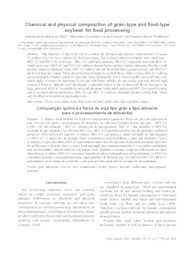Chemical and physical composition of grain-type and food-type soybean for food processing.
Chemical and physical composition of grain-type and food-type soybean for food processing.
Autoria: SILVA, J. B. da; CARRÃO-PANIZZI, M. C.; PRUDÊNCIO, S. H.
Resumo: The objective of this work was to evaluate the chemical and physical characteristics of grains of soybean (Glycine max) cultivars for food processing. The soybean cultivars evaluated were: grain-type - BRS 133 and BRS 258; food-type - BRS 213 (null lipoxygenases), BRS 267 (vegetable-type) and BRS 216 (small grain size). BRS 267 and BRS 216 cultivars showed higher protein content, indicating that they could promote superior nutritional value. BRS 213 cultivar showed the lowest lipoxygenase activity, and BRS 267, the lowest hexanal content. These characteristics can improve soyfood flavor. After cooking, BRS 267 cultivar grains presented a higher content of aglycones (more biologically active form of isoflavones) and oleic acid, which makes it proper for functional foods and with better stability for processing, and also showed high content of fructose, glutamic acid and alanine, compounds related to the soybean mild flavor. Because of its large grain size, BRS 267 is suitable for tofu and edamame, while small-grain-sized BRS 216 is good for natto and for soybean sprouts production. BRS 216 and BRS 213 cultivars presented shorter cooking time, which may be effective for reducing processing costs.
Ano de publicação: 2009
Tipo de publicação: Artigo de periódico
Palavras-chave: Amino acids, Aminoácido, Aminoácidos, Açúcar, Açúcares, Fatty acids, Glycine Max, Grão, Hexanal, Isoflavonas, Isoflavones, Lipoxigenase, Lipoxigenases, Nutrição Humana, Processamento de alimentos, Soja, Soja tipo alimento, Soja tipo grão, Tecnologia de Alimento, Ácido Graxo, Ácidos graxos
Observações
1 - Por padrão são exibidas publicações dos últimos 20 anos. Para encontrar publicações mais antigas, configure o filtro ano de publicação, colocando o ano a partir do qual você deseja encontrar publicações. O filtro está na coluna da esquerda na busca acima.
2 - Para ler algumas publicações da Embrapa (apenas as que estão em formato ePub), é necessário ter, no celular ou computador, um desses softwares gratuitos. Sistemas Android: Google Play Livros; IOS: iBooks; Windows e Linux: software Calibre.
Acesse outras publicações
Acesse a Base de Dados da Pesquisa Agropecuária (BDPA) para consultar o acervo completo das bibliotecas da Embrapa.

